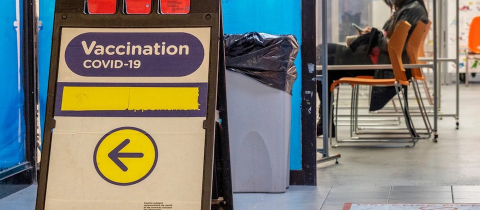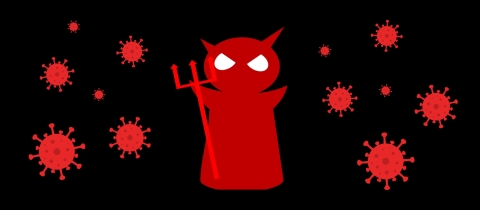On March 28, 2020, at the beginning of the pandemic, the World Health Organization (WHO) tweeted out, “FACT: #COVID19 is NOT airborne.”
For medical doctors and biomedical scientists (including me), this made sense. Few diseases were known to be airborne.
But to aerosol scientists, this was both puzzling and infuriating.
Over the next two years, the WHO and other organizations that had initially denied that the new coronavirus could stay in the air and move around like smoke quietly changed their stance. The virus could spread via respiratory droplets—those heavy globs that come out of our nose and mouth and rapidly fall to the ground—but it could also, these public bodies begrudgingly admitted, hang in the air and be breathed in by someone further away.
Now that the droplet dogma has been appropriately pilloried, the questions are: can ventilation and air filtration rescue us? And what made aerosols so taboo in our public discussions?
Dogma, counter-dogma
The irony of airborne denialism is that it is the product of rejecting an earlier dogma about all diseases being airborne. It’s the old bit about the pendulum: it swings from one extreme to the other, before making its way back to the first extreme. Over time, though, as the pendulum experiences friction, its movement becomes more nuanced and it starts to point in a more reliable direction. And this is, hopefully, where we find ourselves now.
A speed run through history can tell us how we got here.
When not blamed on divine punishment, diseases were, for most of human history, attributed to foul air. The word “malaria” literally means “bad air” in Medieval Italian. “Drain the swamp” was a motto of the Roman Empire, since swamps were thought to be breeding grounds for tiny, airborne creatures that made people sick. From the fourth century BCE to 1880, we in the West lived in the era of miasma theory: bad air caused bad things for humans.
The pendulum started to swing when evidence accumulated that invisible germs were making us sick. The greatest hits from that era include John Snow and the infamous Broad Street water pump tied to cholera; Ignaz Semmelweis and the practice of handwashing before delivering babies; and the invention of the microscope, which allowed our eyes to finally catch sight of those microbes. Then, of course, Louis Pasteur and Robert Koch. Eventually, this impressive line of evidence led us to Charles Chapin, not the famous actor but a physician recognized as a pioneer in public health research. He rejected the idea of bad air and believed droplets full of microbes were to blame for common contagious diseases. In fact, he wrote in 1912 that doctors were “warranted, then, in discarding [airborne transmission] as a working hypothesis and devoting [their] chief attention to the prevention of contact infection.”
And from 1910 to 1962, the common belief was that no natural disease was airborne.
In the second half of the twentieth century, however, the medical community had to walk this belief back a bit. First, there was tuberculosis. In an elegant experiment published in 1962, guinea pigs were made to breathe air piped in from a tuberculosis ward. They got sick. But there was one group of guinea pigs that didn’t get infected: the one whose air supply was irradiated by germ-killing ultraviolet light on its way from the ward. Clearly, tuberculosis was in the air.
Superspreading events of measles and chickenpox forced the medical community in the 1980s to accept that those microbes could also hang around in the air and infect people. But these diseases were seen as exceptions.
It shouldn’t be surprising, in retrospect, that major public health agencies were asking aerosol scientists for extraordinary evidence before endorsing the idea that COVID-19 was airborne. They saw it as an extraordinary claim, since it appeared to them to be so rare. But despite their resistance, there is evidence that many respiratory diseases, like the flu and the common cold, can be spread via tiny aerosols that don’t rapidly fall to the floor.
In 2022, it takes a Herculean effort to deny that SARS-CoV-2 is airborne, especially given the Omicron variant’s stunning contagiousness. Some still reject this reality. Others have been busy proposing solutions.
It’s airborne. Now what?
So you’ve got a room, say a classroom, and want to know what to do about the potential SARS-CoV-2 aerosols.
Is the ventilation adequate? To assess this, a nondispersive infrared (NDIR) CO2 sensor can be used. “You want the air in your house [or indoors] to be as fresh as the outdoor air,” Professor Kimberly Prather told me. She is an atmospheric chemist at the Scripps Institution of Oceanography and UC San Diego who studies aerosols. We humans breathe air in, hold onto the oxygen, and breathe out CO2. An NDIR CO2 sensor uses a specific beam of infrared light that CO2 molecules love to absorb. The more CO2 in the detector, the less infrared hits the sensor. The device translates this into the amount of CO2 present in the air in parts per million (ppm). “When people release CO2 into a shared room, that number creeps up. All that means is that you are breathing other people’s shared breaths. We don’t want that.” The CO2 detector cannot tell you if the virus is present. But if the virus is present, large quantities of CO2 means ventilation is bad and those aerosolized viruses are not leaving the room anytime soon. “If I see 1,000-2,000 ppm, I’m out of there. Schools that say ‘our rooms are safe,’ they better prove it, with kids present.”
Professor V. Faye McNeill, who researches aerosols and air quality in the Department of Chemical Engineering at Columbia University, agrees. “As a rule of thumb, if a room has between 600 and 800 ppm CO2, that’s pretty good. Over 1,000 ppm, that is an indicator that ventilation is insufficient.” Even if SARS-CoV-2 didn’t exist, high amounts of CO2 in the air is not particularly healthy.
If a room filled to its usual capacity with people has unacceptable levels of CO2, the first thing to do is to improve ventilation. “Opening a window is actually a very, very good way of getting dilution of the air,” Professor Parisa Ariya from our own Department of Chemistry told me. A bit of bad indoor air gets diluted when fresh outdoor air is allowed in. Even simply opening two windows a little bit can make a big difference and will be better tolerated in harsher winter climates than opening a single-window all the way. For older buildings that do not have mechanical heating, ventilation, and air conditioning (HVAC) systems, windows and doors are pretty much the only ventilation options. For newer buildings, improving HVAC parameters and schedules can boost air circulation. Checking to see if air is moving around can be as simple as lighting a match and tracking the smoke. Where the smoke goes is where the air goes
If ventilation isn’t enough, we can turn to filtration. “Filtration is when you keep the air but remove the virus from the air,” Professor José Luis Jiménez told me. He is a distinguished professor of chemistry at the University of Colorado Boulder with expertise in aerosols, and he has been very vocal about recognizing SARS-CoV-2’s airborne nature. Masks work by filtering the air before it reaches our nose, and there are devices that do the same for a room.
Often called “air purifiers” (“it’s a misleading marketing term,” Prof. Jiménez said to me), air cleaners or air filtration devices use a fan and filters to remove tiny particles from the air. They are quite effective at filtering out the coronavirus, but stores selling them will give you choice paralysis. The aerosol experts I spoke to all pretty much agreed on what to look for.
HEPA filters work well but can be expensive. “They’re so efficient that, in one air pass, they pull all the viruses and everything out, but they don’t pump enough air through, so the air flow is very low,” Prof. Prather told me. They also have to be the right size for the room. (This spreadsheet can help figuring this out). “I’ve gone to doctors and dentists here in Boulder,” Prof. Jiménez confessed to me, “and they have HEPA filters, but they’re tiny, about ten times smaller than they should be. And they have them either off or on the lowest setting, so it’s basically a talisman.”
Homemade air cleaners in the shape of a box made out of filters with a fan on top (known as Corsi-Rosenthal boxes, after two respected scientists in the field who came up with them) actually work extremely well, even with furnace filters instead of HEPA filters, and are much cheaper. Look for filters that are thick and heavily pleated, as they will provide more surface area for filtration. “There are videos of seven-year-olds building them and presenting them at their school,” said Prather. “The kids and parents feel like they’re doing something to help.” Schools may balk at homemade equipment, but these boxes have been shown to work surprisingly well, “blowing the competition out of the water,” Prather told me.
You will find that filters are rated based on their ability to deal with 0.3-micron particles. These are the most difficult to capture. It’s a size that falls in between two different filtration mechanisms. Filters that do well with 0.3-micron particles are even better at filtering out other sizes. The coronavirus on its own is roughly 0.05 to 0.2 micron, but the aerosols that contain it, full of mucus and salt, are about 5 microns in size.
If buying a unit instead, stay away from bells and whistles, advertised on the packaging as using ions, plasma, photocatalysis, or releasing substances like ozone or hypochlorous acid into the air. They may not work as advertised and they may even put your health at risk by creating molecules in the air like hydroxyl radicals that can harm your body when breathed in high enough concentrations. The device should be certified to not generate ozone. Even air cleaners that use ultraviolet light are not typically recommended. “To do it properly, it’s more expensive and more complicated and has to be done professionally,” Prof. Jiménez said. “Sometimes the UV can damage the filter,” which defies its purpose. Fans and filters are best, no cutting-edge gadgetry necessary.
And those air cleaners, either store-bought or homemade, should be placed away from walls and corners where airflow is obstructed. The centre of the room is often ideal but not always practical. Two air cleaners on a lower, less noisy setting may be more tolerated than a single air cleaner at full speed making a racket in the middle of a classroom. Many recommend six air changes per hour. I was told that three should be the bare minimum, although it really depends on the situation.
When air filtration is underway, keep in mind that your CO2 detector will not notice the change. That’s because the air cleaner does not remove CO2 from the room, but it will clean the air of the virus. That’s why CO2 detectors are a good way of assessing ventilation needs, but they cannot tell you that the air filtration device is doing its job.
Finally, to change the filter (usually every six months, although it will depend based on usage), put on a mask and a pair of gloves and change the filter outside. The filter holds onto the virus, so out of an abundance of precaution, treat the used filter like it could infect you.
Some will push back against all this by quoting a study whose manuscript, not yet peer-reviewed or officially published, was posted on the Internet earlier this week. Its scientists artificially sprayed SARS-CoV-2 aerosols in the air and reported that the majority stopped being infectious within 10-20 minutes, with most of that loss happening within the first five minutes. Prof. Jiménez tweeted that while the experiments were very elegant, the conclusions were overstretched. Prof. Ariya, who had not yet read the study when I spoke to her, reminded me that “five minutes is a lot.” Indeed, especially since an infected person does not exhale only once. They do it continually.
The COVID comet
In speaking to aerosol scientists, I heard the phrase “epistemic trespassing.” It’s when experts pass judgment on issues on which they lack expertise. Many public health scientists and physicians did not believe that COVID-19 was airborne and were pretty vocal about it, and they rejected calls for better ventilation, air filtration, and CO2 monitoring. This was wrong. “We know this stuff works!” Prof. Jiménez told me emphatically. “It’s not rocket science! And it’s not infectious disease medicine! It’s physics and engineering.” Aerosol scientists have, during the pandemic, felt like they were stuck in their own version of the movie Don’t Look Up, in which no one believes the scientists who say a comet will collide with our planet.
To survive the airborne COVID comet, Jiménez gave me a hierarchy of solutions. Priority #1, moving activities outdoors whenever possible. The virus gets diluted in the air. Priority #2, N95 masks or their equivalent, paying attention to fit. Priority #3, room ventilation and air filtration.
Dr. Charles Chapin, who was convinced most contagions were not airborne (though he left the metaphorical door open for him to change his mind), once wrote a sentence that might explain today’s resistance to the idea of airborne disease: “It will be a great relief to most persons to be freed from the spectre of infected air.” Fear might indeed be one reason why so many organizations were shy to admit COVID-19’s airborne nature, even in the face of accumulating evidence. What if the public panics?
“Once you acknowledge it is airborne,” Professor Prather told me, “it is so fixable. We have easy ways to fix it. The public should be excited, honestly, to get out and fix it!” We can test the ventilation of a room with CO2 sensors. We can open windows. We can buy air filtration devices or build our own. We can wear better masks. Compared to COVID-19 laboratory tests and mRNA vaccines, both of which have played stellar roles in controlling the pandemic, these old-school solutions are easy. And people, once the idea of “bad air” is explained to them, will understand. After all, this account of how people catch diseases has been with us for millennia. “The public,” Prather concluded, “is much smarter than they’ve been given credit for.”
P.S.: For an in-depth reference on COVID-19 aerosol transmission, this Google document is very thorough.
Take-home message:
-SARS-CoV-2, the virus that causes COVID-19, can stay in the air in the form of tiny aerosols
-Transmission of the virus indoors can be reduced with good ventilation, which can be evaluated using an NDIR CO2 sensor, with CO2 amounts above 1,000 ppm showing insufficient ventilation
-Filtering the virus out of the air can be achieved using air cleaners, including homemade Corsi-Rosenthal boxes







